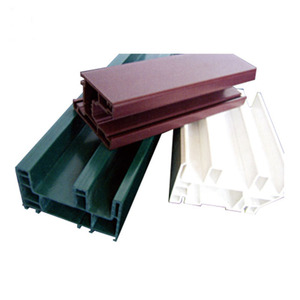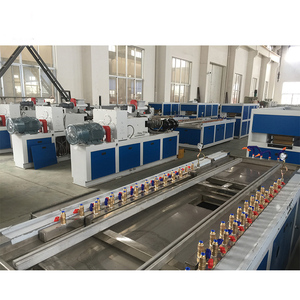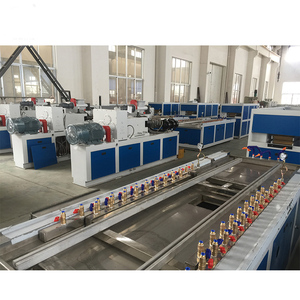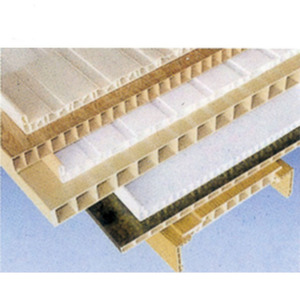
All categories
Featured selections
Trade Assurance
Buyer Central
Help Center
Get the app
Become a supplier

(679 products available)




















The siding panel extrusion machine is crucial in producing siding panels. It comes in various types, each with unique features and capabilities.
Single screw extruder
A single screw extruder for siding is a machine used to produce siding products by melting and shaping plastic materials through a single screw. This machine consists of a hopper, where the raw material is fed, and a heated barrel containing a single screw that rotates and moves the material forward. As the material moves through the barrel, it is heated and melted, taking the shape of the screw thread. Once the material is melted and shaped, it is forced through a die to create the siding shape. Single screw extruders are commonly used in the production of vinyl siding and other plastic siding materials.
Double screw extruder
The double screw extruder for siding is a machine that produces siding materials by melting and mixing plastic resins using two intermeshing screws. Unlike single screw extruders that rely on forward displacement for mixing, double screw extruders have two parallel screws that rotate and mix the material thoroughly. This design allows for better mixing and homogenization of the melted plastic, resulting in siding materials with consistent quality and composition. Furthermore, the double screw extruder enables the addition of fillers and additives to the plastic resin to enhance the properties of the siding material. Double screw extruders are often used in producing siding materials that require specific additives or when a higher level of quality control is needed.
Co-extrusion siding machine
The co-extrusion siding machine is a specialized pe to create siding materials with multiple layers using the co-extrusion process. This machine allows for the simultaneous extrusion of different colored or textured materials to create siding products with varied finishes and improved durability. The co-extrusion process involves combining two or more materials directly into a single product without layering or separate processing. This provides better adhesion between the layers and enhances the performance of the siding material, commonly used to produce vinyl siding with a different material for the color layer and the underlying layer.
Multi-way extrusion machine
The multi-way extrusion machine is a versatile equipment that can produce siding materials of various shapes and sizes by using multiple extrusion heads. It allows for the simultaneous production of multiple siding products, increasing productivity and efficiency in the manufacturing process. Additionally, the machine can use different materials to produce siding products with different configurations. Generally, the multi-way extrusion machine is suitable for manufacturing facilities that need to produce multiple types of siding materials to meet various market demands.
Production capacity:
This is usually measured in kilograms per hour (kg/h) or pounds per hour (lbs/h). For example, a machine with a production capacity of 50-100 kg/h can produce 50 to 100 kilograms of siding panels in one hour.
Power
The power of an extrusion machine is usually expressed in kilowatts (kW) or horsepower (hp). For example, a machine with a power of 15-30 kW means that it uses 15 to 30 kilowatts of power, which is sufficient to provide the energy needed for extrusion processing.
Material compatibility:
For example, the machine can be compatible with materials such as PVC, PP, PET, EVA, etc., which means that it can process these specific plastic materials to produce corresponding products.
Dimensions:
For example, the length of the extrusion machine is 5 meters; the width is 1.5 meters, and the height is 2 meters, which shows the space occupied by the machine and its size in the workshop.
Temperature control:
The machine's ability to precisely control temperature is critical to the quality and performance of the extruded product. For example, the temperature control range of an extrusion machine is from room temperature to 300 degrees Celsius, which enables it to adapt to the temperature requirements of different materials and processes.
Weight:
For example, the weight of a siding panel extrusion machine is 2000 kg, which is equivalent to 2 tons, indicating that it is a large piece of equipment with considerable weight.
Routine checks:
Regularly inspect the appearance to make sure that the surfaces of various components are free of debris and blockages. Regularly check the tightness and alignment of the machine parts, such as chains, belts, etc., and make adjustments or replacements as necessary. Regularly inspect electrical components and circuits for loose connections or leakage, and deal with them in time if problems are found.
Lubrication:
According to the machine manual, regularly add lubricating oil to the movable parts of the machine to ensure smooth operation and reduce friction and wear. Regularly inspect and replace lubricating oil for reduction gears and bearings to keep them running properly.
Cleaning:
Clean the material feeding hopper and conveying portions of the extrusion machine to prevent contamination of the extruded materials by foreign objects. Clean the cooling system to make sure that the cooling channels and fans are free of blockages and dust. Regularly clean the die and template of the extrusion machine to ensure that the mold cavities are not clogged and maintain stable molding quality.
Pay attention to operating skills:
When maintaining the extrusion machine, it is necessary to ensure that the power is turned off and the equipment is stationary to avoid accidental operation and guarantee safety. Pay attention to the handling skills to avoid damage to components or injury to personnel when replacing and maintaining parts.
Siding panel extrusion machines are used in numerous applications. Here are some of the most common scenarios where the machine is used.
Designing customized siding materials
The extrusion machine allows businesses to create uniquely designed siding materials that can satisfy particular market demands. They can modify elements like thickness, color, texture, and profile shape to produce siding panels that fit niche application requirements or architectural styles.
Renovation and remodeling projects
In home renovation and remodeling, a siding extrusion machine can assist builders in changing existing siding materials to achieve new looks. For instance, they can replace old siding materials with new ones to give the home a modern appeal.
Construction of new residential and commercial buildings
In the construction industry, the siding panel extrusion machine is used to create external wall coverings for new residential and commercial buildings. The custom-made panels protect the buildings against harsh weather elements. Also, they enhance the aesthetic appeal of different kinds of constructions.
Creating environmentally-friendly materials
Using the siding panel extrusion machine, one can produce siding materials that come from recycled plastics. Such materials appeal to builders and homeowners who are concerned about the environmental impact of their construction projects.
Developing Innovative Siding Technologies
The machine enables manufacturers to create intelligent siding solutions that have embedded technologies for remote control, self-cleaning, or energy efficiency.
When choosing an extrusion machine for siding panels, consider these factors.
Production capacity:
SIDING Extrusion machines' production capacities vary. Choose an extrusion machine with a production capacity that meets the business's needs. A machine with a small production capacity may result in constant orders. In contrast, one with a higher capacity may produce excess material that may not be used.
Material compatibility:
Extrusion machines work well with one material. Others have a wider range of compatibility. Some clients may prefer sidings made from metal or wood plastic composites. Selecting an extrusion machine with material compatibility is essential to fulfilling customers' desires.
Quality:
A poor-quality machine may constantly break down and affect the product's quality. An overhaul budget with many repairs may be higher than purchasing a new, high-quality machine. One way to be sure of quality is to choose machines from popular manufacturers with many years of experience.
Cost:
The siding panel extrusion machine cost may be low. In the long run, it may be higher due to maintenance costs and the eventual cost of replacing the machine. Examining machines closely and choosing good material and build quality are sure ways to reduce costs in the long run.
Technical support:
It's easy to pick a manufacturer of extra machines to work with if there is sufficient technical support. Many manufacturers have trained and experienced staff ready to assist customers with their needs. Choose a manufacturer that provides good technical support to reduce downtime.
Q1: What materials can a siding panel extrusion machine work with?
A1: It depends on the specific machine model. The most common materials are PVC, Polystyrene, and Polypropylene.
Q2: What is the lifespan of siding extrusion?
A2: If the siding is well maintained and there are no extreme weather or incident conditions, it could last up to 40 years.
Q3: What are the three most common types of siding?
A3: PVC is the most common because it is low cost. Fiberglass is much stronger than plastic but will cost more. Polypropylene is stronger than many materials but could also be more expensive.
Q4: What are some common problems with extruded siding?
A4: Color change, warping, cracking, and crazing are the most common problems. Some of these could be prevented by using high-quality materials and additives.